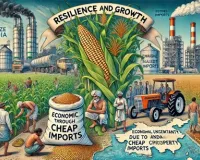GST 2.0: A Pro-Middle Class Reform That Reshapes Spending Power
Digital Desk
1.jpg)
The recent overhaul of India's indirect tax system, dubbed GST 2.0, marks a significant policy pivot. By slashing taxes on everyday items and raising them on luxury goods, the reform delivers tangible relief to middle-class households while applying a progressive tax principle to the affluent, aiming to stimulate broader economic growth.
For India's common man, the new tax structure, effective September 22, 2025, is like a welcome early Diwali gift. The government has fundamentally restructured the complex multi-tiered system into a simpler two-slab framework 5% for essentials and 18% for standard goods while introducing a new 40% demerit rate for luxury and sin goods .
A Direct Boost for Middle-Class Budgets
The most immediate impact of GST 2.0 for the middle class is the increased disposable income, coming on the heels of income tax relief for those earning up toRs.12 lakh . This double benefit is strategically designed to spur consumption.
- Kitchen & Pantry: The financial strain of monthly grocery shopping is set to ease. Staples like butter, ghee, packaged snacks, dry fruits, and pasta have seen their GST slashed to 5% . Delightfully, frozen parathas, paneer, and khakhra are now fully exempt from tax, making daily meals more affordable .
- Personal Care: Items like hair oil, toothpaste, and shampoo have moved from 18% to the 5% slab, reducing the cost of daily necessities .
- Aspirational Goods: The festive season just got more exciting. Large-screen TVs, refrigerators, air conditioners, and washing machines have become significantly more accessible, with their GST rates reduced from a steep 28% to 18% . This makes upgrading household appliances less of a financial burden.
- Health & Security: In a major relief, individual health and life insurance premiums are now completely exempt from GST, previously taxed at 18% . This not only lowers costs but also encourages wider insurance penetration. Furthermore, over 30 life-saving drugs have been moved to a nil GST slab .
Reports suggest that the collective impact of these changes could lead to a 27-30% relief in taxes for Indian households and boost real purchasing power for the middle class by 3-4% .
The Elite: A Shift in Tax Burden
For the affluent, GST 2.0 introduces a steeper fiscal responsibility. The policy deliberately targets discretionary and luxury consumption through a new 40% tax slab .
This higher rate applies to goods such as luxury cars with larger engines, yachts, and aircraft for personal use . The underlying principle is progressive taxation—that those with a greater ability to pay should contribute a larger share to the exchequer . While this may marginally erode the purchasing power of the elite by 1-2%, the demand for these high-end goods is often relatively inelastic, ensuring steady revenue for the government .
The Bigger Economic Picture
The government is making a calculated bet that by putting an estimated Rs.2 lakh crore annually back into the hands of consumers, it can revive household demand, which constitutes about 60% of India's GDP . This consumption-led growth is expected to benefit sectors like FMCG, retail, and manufacturing, potentially creating a virtuous cycle of investment and job creation .
However, the reform is not without its challenges. Some analysts project a revenue shortfall of up toRs.48,000 crore, and states are anticipating annual losses ofRs.8,000-10,000 crore, which the central government will need to manage .
The Bottom Line
GST 2.0 is more than just a tax tweak; it is a conscious rebalancing act. It eases the financial pressure on the middle class, the backbone of the Indian economy, while leaning on the affluent to help foot the bill. For the common man, it translates into cheaper daily essentials, more affordable appliances, and better financial security—a tangible improvement in the ease of living. Its ultimate success will be measured by how effectively it fuels consumption without destabilizing fiscal health, making it one of the most consequential economic experiments in recent years.


2.jpg)
3.jpg)


3.jpg)


2.jpg)

